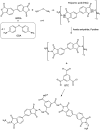Polyimide aerogels with novel bimodal micro and nano porous structure assembly for airborne nano filtering applications
- PMID: 35520303
- PMCID: PMC9054633
- DOI: 10.1039/d0ra03907a
Polyimide aerogels with novel bimodal micro and nano porous structure assembly for airborne nano filtering applications
Abstract
Aerogels have presented a very high potential to be utilized as airborne nanoparticles' filtration media due to their nanoscale pore size and extremely high porosity. The filtering performance of aerogels, such as air permeability and filtration efficiency, is highly related to the configuration of aerogels' nanostructure assembly. However, as aerogel morphology is formed with respect to the intermolecular forces during the gelation stage, tailoring the aerogel nanostructure assembly is still a challenge. In this work, a novel strategy for tailoring polyimide aerogel nanostructure assembly is proposed by controlled disturbing of the intermolecular forces. From the results, the nanostructure assembly of the 4,4'-oxydianiline (ODA)-biphenyl-tetracarboxylic acid dianhydride (BPDA) polyimide aerogel is tailored to a uniform bimodal micro and nano porous structure. This was achieved by introducing the proper fraction of thermoplastic polyurethane (TPU) chains to the polyimide chains in the solution state and through a controlled process. The fabricated polyimide/TPU aerogels with bimodal morphology presented enhanced filtration performance, with 30% improved air permeability and reduced cell size of 3.51 nm over the conventional ODA-BPDA polyimide aerogels. Moreover, the fabricated bimodal aerogels present the reduced shrinkage, density, and effective thermal conductivity of 6.3% and 0.063 g cm-3, 28.7 mW m-1 K-1, respectively. Furthermore, the bimodal polyimide/TPU aerogels show the higher porosity of 96.5 vol% along with increased mechanical flexibility over the conventional polyimide aerogel with comparable backbone chemistry.
This journal is © The Royal Society of Chemistry.
Conflict of interest statement
The authors declare that they have no known competing financial and non-financial interests that could have appeared to influence the work reported in this paper.
Figures









Similar articles
-
Tuning Porous Networks in Polyimide Aerogels for Airborne Nanoparticle Filtration.ACS Appl Mater Interfaces. 2017 Sep 6;9(35):30074-30082. doi: 10.1021/acsami.7b09345. Epub 2017 Aug 24. ACS Appl Mater Interfaces. 2017. PMID: 28806054
-
Surface Modification of Polyimide Aerogel by Thermoplastic Polyurethane for Enhanced Mechanical Strength and Thermal Insulation Performance.ACS Appl Mater Interfaces. 2024 Jun 5;16(22):29282-29290. doi: 10.1021/acsami.4c05455. Epub 2024 May 23. ACS Appl Mater Interfaces. 2024. PMID: 38780962
-
Quantitative Evaluation of the Hierarchical Porosity in Polyimide Aerogels and Corresponding Solvated Gels.ACS Appl Mater Interfaces. 2020 Jul 8;12(27):30457-30465. doi: 10.1021/acsami.0c07971. Epub 2020 Jun 26. ACS Appl Mater Interfaces. 2020. PMID: 32538072
-
Recent advances in tailoring and improving the properties of polyimide aerogels and their application.Adv Colloid Interface Sci. 2022 Jun;304:102646. doi: 10.1016/j.cis.2022.102646. Epub 2022 Mar 21. Adv Colloid Interface Sci. 2022. PMID: 35378358 Review.
-
Advances in precursor system for silica-based aerogel production toward improved mechanical properties, customized morphology, and multifunctionality: A review.Adv Colloid Interface Sci. 2020 Feb;276:102101. doi: 10.1016/j.cis.2020.102101. Epub 2020 Jan 11. Adv Colloid Interface Sci. 2020. PMID: 31978639 Review.
Cited by
-
Magnetic aerogel: an advanced material of high importance.RSC Adv. 2021 Feb 11;11(13):7187-7204. doi: 10.1039/d0ra10275j. eCollection 2021 Feb 10. RSC Adv. 2021. PMID: 35423256 Free PMC article. Review.
-
Aerogel-Based Biomaterials for Biomedical Applications: From Fabrication Methods to Disease-Targeting Applications.Adv Sci (Weinh). 2023 Aug;10(23):e2204681. doi: 10.1002/advs.202204681. Epub 2023 May 22. Adv Sci (Weinh). 2023. PMID: 37217831 Free PMC article. Review.
References
-
- Aegerter M. A.; Leventis N. and Koebel M. M., Aerogels Handbook, Springer, New York, 2011
-
- Liu Q. Chen J. Mei T. He X. Zhong W. Liu K. Wang W. Wang Y. Li M. Wang D. J. Mater. Chem. A. 2018;6:3692–3704. doi: 10.1039/C7TA10107D. - DOI
LinkOut - more resources
Full Text Sources
Other Literature Sources

